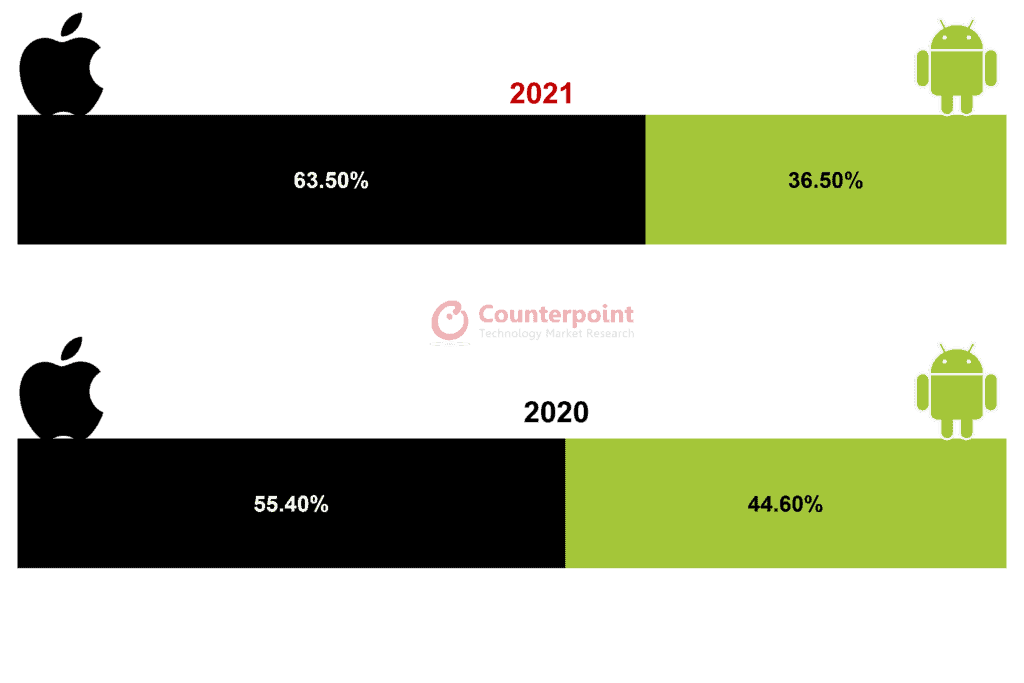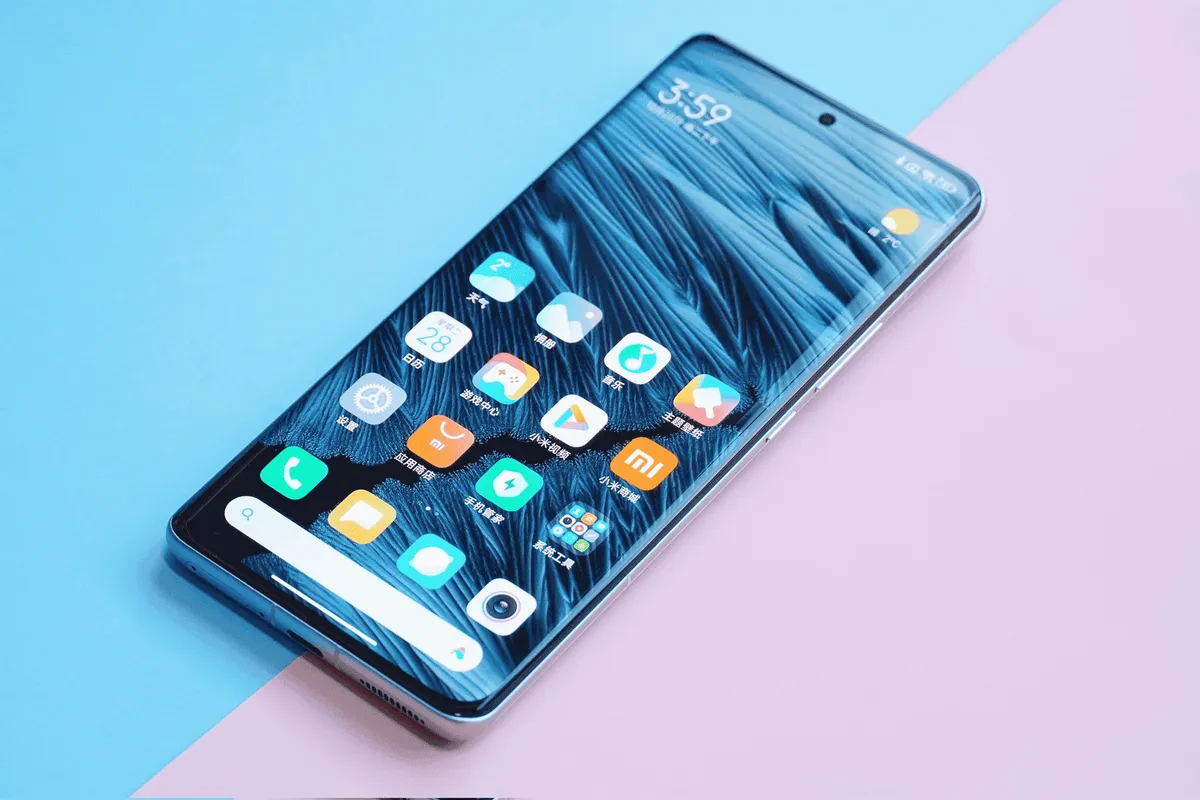Chinese smartphone manufacturers are not really kin on the flagship market. Apart from Huawei and OnePlus, others seem to focus on cost-effective smartphones. However, since the technical exit of Huawei from the market, other Chinese brands have stepped up their game on the flagship smartphones end. However, this does not seem to be making much impact. Judging from the latest data, other Chinese brands have not successfully seized the high-end market space vacated by Huawei.

According to Counterpoint Research, with the increase in the average selling price (ASP) of smartphones, it is also reasonable for Chinese mobile phone brand manufacturers to turn to the higher-end market with higher profits.
However, successfully launching a high-end smartphone model is no easy task. In 2021, the market share of Android smartphones priced above $600 in China will shrink from 44.6% in 2020 to 36.5%. Counterpoint said that while it is foreseeable that Android smartphones will be able to regain some market share from iOS this year, it will not be easy.
According to Counterpoint analysts' observations, flagship smartphones must do well on three fundamentals.
1. Display
The primary focus is the display, and high-end smartphone screens need to support high refresh rates, high resolutions, and cutting-edge color accuracy. We can now see more high-end smartphones that support the DCI-P3 color gamut. Meanwhile, LTPO screens are now a must for high-end smartphones to support variable refresh rates.
2. Camera
The second aspect of flagship smartphones is photography. In the age of computational photography, manufacturers are improving the specifications of ANC-assisted cameras. For example, smartphones now have ultra-high-resolution ultra-wide-angle cameras or periscope telephoto lenses, etc. In addition, high-end smartphones are touting their multi-camera collaboration to capture more information for AI algorithms to process.
RYYB ultra-sensitive sensor
The RYYB ultra-sensitive sensor is a typical representative of imaging technology. It is also a key technology to solve "dark shooting" imaging. The groundbreaking use of a 1/1.7-inch sensor was in the Huawei P20 Pro, which was the largest image sensor in the smartphone market at the time. The Huawei P30 series revolutionarily replaces the RGGB pixel arrangement used in traditional CMOS with an RYYB array. This greatly improves the light input efficiency at the pixel level. In the Huawei P40 series, the super-sensing main camera has a photosensitive area of up to 1/1.28 inches.
Focus
Another example is the focus. Top brands now place more emphasis on full-pixel octa-core focusing technology. This technology can comprehensively improve sensitivity, focusing speed, and accuracy, and can perform high-precision focusing on smaller objects. Especially in low-light environments, even a random phone shot in normal mode is even better than some long-exposure night scene modes. This makes it possible to shoot a night scene blockbuster at night.
Multi-spectral sensors
In addition, multi-spectral sensors make images more accurate in color, texture, light, and shadow. This makes the complexion of light sources and backgrounds more accurate. The P50 series is the industry's first smartphone with an ultra-broad-spectrum camera. Thanks to the 10-channel multi-spectral sensor's insight into the law of light propagation, it simulates the process of human eyes seeing light and improves the resolution of the ambient spectrum. The resolution is also more accurate and realistic.
Image processing
With the continuous iteration of technology, AI photography technology now makes processing better. It changed the industry's pure hardware and pure algorithm solutions, through the "real world - imaging system - post-processing algorithm" solution. At the moment of taking pictures, the light of each scene and each wavelength is gathered by the lens and then converted into electrical signals by the sensor.
The neural network of the AI algorithm summarizes the characteristics of the optical signals from the massive data information, fits and adjusts the model parameters, takes overall consideration, and calculates the optical signal before it is degraded by aberrations. It presents the natural scenes in reality as they are. It also records the light and shadow of the real world.
The XD Fusion image also introduces the concept of computational photography. Based on the super-perceptual image acquisition of all focal lengths, all environments, and all periods of time, a new super-sensing image was introduced. The filter system, primary color engine, and ultra-dynamic range technology have comprehensively improved imaging capabilities in detail.
Innovation is not dazzling
Nowadays, almost every mobile phone manufacturer is talking about the innovation of imaging technology. However, only innovation that truly solves and meets the needs of users can truly lead. Innovation is not a simple hardware innovation. Only by taking into account the collaborative innovation of software and hardware, and making a good trade-off and balance between space and image quality, can we truly take the lead. This is what flagship smartphones need.
3. Gaming
The third is the game experience. Mobile games now consume more computing resources than before to meet gamers' demands for transparent graphics and a smooth gaming experience. Temperature is another important factor, and no one wants to burn their phone while gaming.
There are three other aspects that are not the most important but are also very beneficial for high-end machines. The first is a reliable signal connection. Some smartphones have 4X4MIMO (Multiple Input Multiple Output) solutions to improve their signal reception. The second is more balanced stereo audio, but no one uses their smartphone's speakers to play music all the time. The third is fast charging or battery sustainability.
If manufacturers want to seize more market share in the high-end market, there is still a lot of homework to do in addition to the hardware. For example, Apple's iPhone not only has good specifications but also has a rich ecosystem.
Conclusion
Flagship smartphones do not just need innovation. They do not just need technology stacking that does not make any difference to users. However, they require innovations (hardware and software optimizations) that solve real-life needs. In recent times, there has been a lot of focus on display, camera and gaming capacity. Of thus three, the camera department seems to be getting more attention. Even gaming smartphones that does not require the best camera systems are now using pretty decent cameras.






Place comments
0 Comments
You are currently seeing only the comments you are notified about, if you want to see all comments from this post, click the button below.
Show all comments